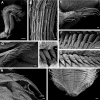Combined morphological and molecular data unveils relationships of Pseudobranchiomma (Sabellidae, Annelida) and reveals higher diversity of this intriguing group of fan worms in Australia, including potentially introduced species
- PMID: 27843378
- PMCID: PMC5096407
- DOI: 10.3897/zookeys.622.9420
Combined morphological and molecular data unveils relationships of Pseudobranchiomma (Sabellidae, Annelida) and reveals higher diversity of this intriguing group of fan worms in Australia, including potentially introduced species
Erratum in
-
Corrigenda: Capa M, Murray A (2017) Combined morphological and molecular data unveils relationships of Pseudobranchiomma (Sabellidae, Annelida) and reveals higher diversity of this intriguing group of fan worms in Australia, including potentially introduced species. ZooKeys 622: 1-36. https://doi.org/10.3897/zookeys.622.9420.Zookeys. 2017 Dec 14;(722):153-155. doi: 10.3897/zookeys.722.21609. eCollection 2017. Zookeys. 2017. PMID: 29308034 Free PMC article.
Abstract
Pseudobranchiomma (Sabellidae, Annelida) is a small and heterogeneous group of fan worms found in shallow marine environments and is generally associated with hard substrates. The delineation and composition of this genus is problematic since it has been defined only by plesiomorphic characters that are widely distributed among other sabellids. In this study we have combined morphological and molecular (mitochondrial and nuclear DNA sequences) data to evaluate species diversity in Australia and assess the phylogenetic relationships of these and other related sabellids. Unlike morphological data alone, molecular data and combined datasets suggest monophyly of Pseudobranchiomma. In this study, a new species of Pseudobranchiomma is described and three others are considered as potential unintentional introductions to Australian waters, one of them reported for the first time for the continent. Pseudobranchiomma pallidasp. n. bears 4-6 serrations along the radiolar flanges, lacks radiolar eyes and has uncini with three transverse rows of teeth over the main fang. In the new species the colour pattern as well is characteristic and species specific.
Keywords: dichotomous key; feather duster worms; invasive species; new species; sabellids; taxonomy; translocations.
Figures











References
-
- Arias A, Giangrande A, Gambi MC, Anadón N. (2013) Biology and new records of the invasive species Branchiomma bairdi (Annelida: Sabellidae) in the Mediterranean Sea. Mediterranean Marine Science 14: 162–171. doi: 10.12681/mms.363 - DOI
-
- Baird W. (1865) Description of several new species and varieties of tubicolous Annelides = tribe Limivora of Grube, in the collection of the British Museum. Part 1. Journal of the Linnean Society of London 8: 10–22.
-
- Bush KJ. (1905) Tubicolous annelids of the tribes Sabellides and Serpulides from the Pacific Ocean. Harriman Alaska Expedition 12: 169–346.
-
- Capa M. (2008) The genera Bispira Krøyer, 1856 and Stylomma Knight-Jones, 1997 (Polychaeta, Sabellidae): systematic revision, relationships with close related taxa and new species from Australia. Hydrobiologia 596: 301–327. doi: 10.1007/s10750-007-9105-2 - DOI
-
- Capa M, Bybee DR, Bybee SM. (2010) Establishing species and species boundaries in Sabellastarte Krøyer, 1856 (Annelida: Sabellidae): an integrative approach. Organisms, Diversity and Evolution 10: 351–371. doi: 10.1007/s13127-010-0033-z - DOI
LinkOut - more resources
Full Text Sources
Other Literature Sources
